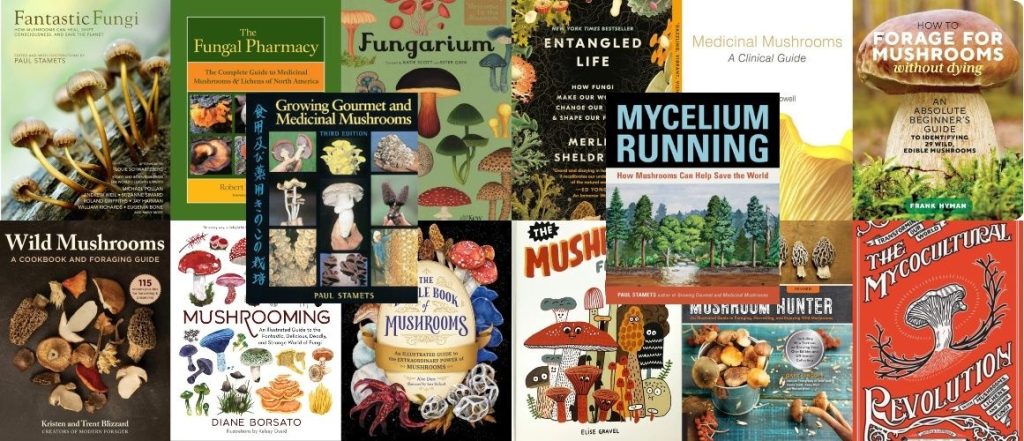For centuries, healers and chefs in the East have foraged, prepared and used mushrooms in meals and extracts for their unique flavors and medicinal properties.
Finally, the Western world is catching up, and mushrooms are receiving lots of attention for medicinal and culinary purposes.
One of the best ways for beginners to learn about mushrooms is a book, and several excellent books are available.
Whether you’re looking to identify wild mushrooms, grow mushrooms at home, start a mushroom farm or use medicinal mushrooms, information-packed books can help you.
If you want to learn how to grow mushrooms or set up a mushroom farm, seeing the process step-by-step is beneficial, and online courses can be an excellent accompaniment to a book.
In this article, we look at 20 of the best mushroom books and explore how they’ll help you understand fungi and identify, grow and use mushrooms successfully.
Types of Mushroom Books
Mushroom books can be split into a few broad categories, including:
- Books about fungi and their impact on the world
- Mushroom identification books
- Mushroom growing books
- Medicinal mushroom books
The list below includes books from all these categories, some spanning more than one.
Below, in no particular order, are 20 of the best mushroom books with information to help you decide which best meets your needs.
Best Books About Fungi
Fungi are remarkable organisms that humans have used for thousands of years for culinary and medicinal purposes. But we are only just beginning to appreciate their true potential.
Fortunately there are some exceptional books that take readers on a journey into the world of fungi, including:
1. “Fantastic Fungi” by Paul Stamets
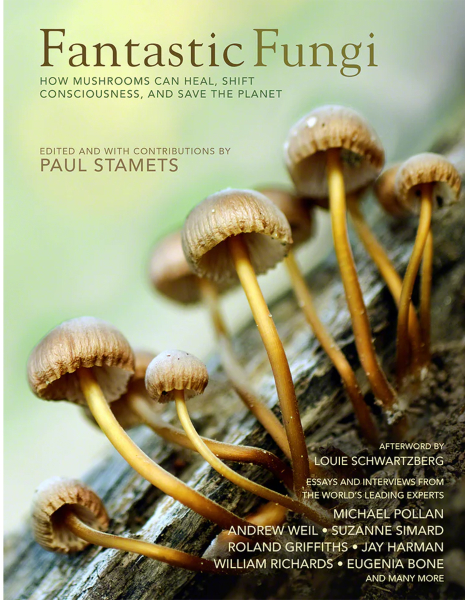
“Fantastic Fungi” is the official companion book to the well-received Fantastic Fungi documentary film.
Written and edited by a team of ecologists, doctors, explorers and fungi experts, including Paul Stamets, it explores how fungi can help restore ecosystems, boost our health and revolutionize our relationship with nature.
This thought-provoking book contains over 400 spectacular photos and information on groundbreaking research demonstrating how we can potentially use fungi to save the planet.
A must-read for anyone interested in fungi that will improve your understanding of how the world works.
Pros
This informative book has numerous pros, including:
- More than 400 incredible photos and graphics that people describe as a visual feast
- Informative with lots of thought-provoking content
- Fun and easy-to-read
- Great coffee table book
Cons
There are not many cons, but depending on your preference, cons may include:
- It’s formatted as a series of essays. Each chapter is written by a different contributor, some better than others.
- It’s not as in-depth as some people would like.
2. “Entangled Life” by Merlin Sheldrake
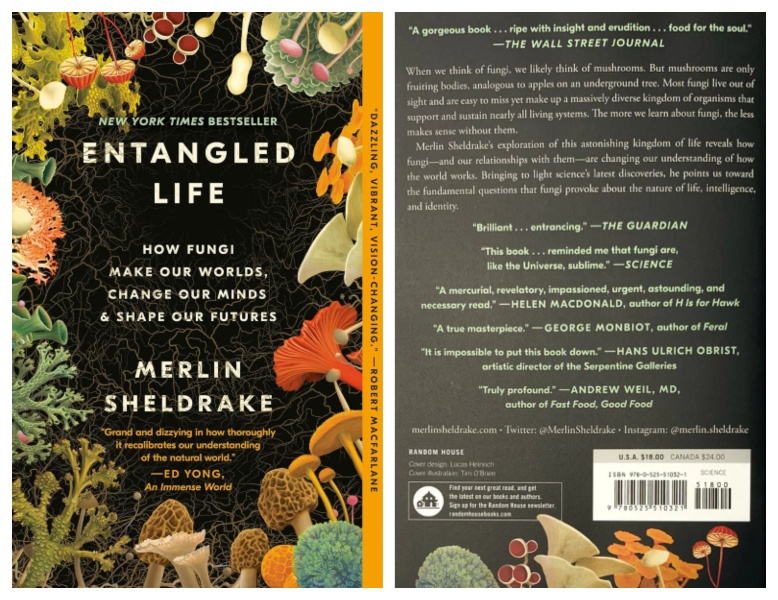
“Entangled Life” is a prizewinning New York Times bestseller that aims to transform our understanding of the natural world and the role fungi play in this world.
The author takes us deep into the fungal world and provides a different perspective on life, showing how they impact ecosystems and can help us and the planet heal.
Pros
This book is a best seller for a reason, and people describe it as being:
- Fascinating and informative
- Containing a pleasing combination of stories, science, history, and theory
- Packed with science-backed information
Cons
While most people love this book, some highlight a couple of cons, including:
- Contains a lot of scientific terms, making it a challenging read for some
- Repeats facts and ideas
3. “Fungarium” by Ester Gaya
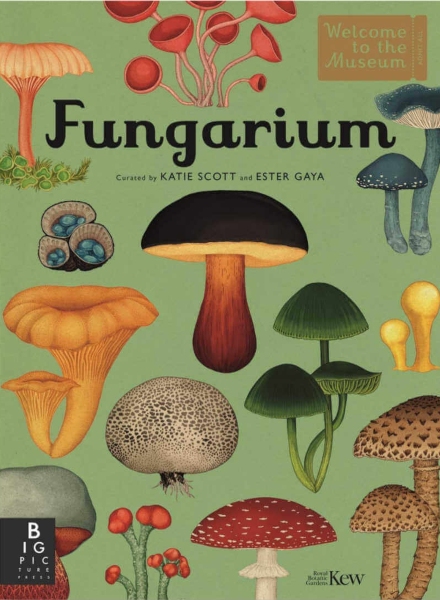
“Fungarium” covers various fungi, from mushrooms in grocery stores to others like penicillium, that have influenced human history.
It’s an essential guide to understanding fungi and highlights their crucial role in our ecosystem.
Talented illustrator Katie Scott provides detailed, full-page illustrations that vividly showcase fungi and their components like spores and hyphae.
This book is part of The Welcome to the Museum series from Candlewick Press, which features a collection of large-format encyclopedia-like books aimed at children. But many adults find them even more appealing.
Pros
This beautiful book makes an ideal coffee table book, and people describe it as:
- Beautifully illustrated and visually stunning
- Educational and well-formatted
- Informative
Cons
This exquisitely illustrated introduction to Kingdom Fungi has few cons, except for a handful of people who feel it needs more realistic illustrations.
But remember, it’s not intended to be a mushroom identification book.
4. “The Mycocultural Revolution” by Peter McCoy
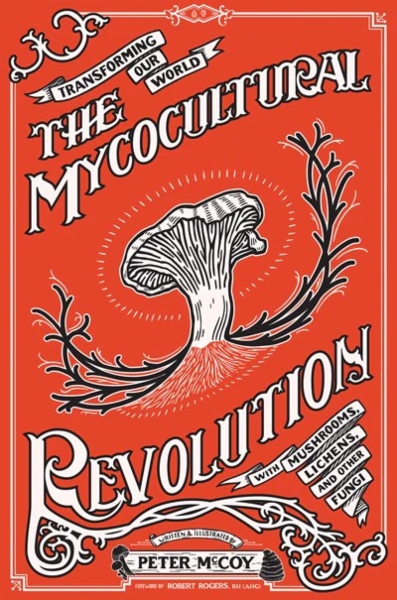
“The Mycocultural Revolution” allows you to explore the fascinating world of mushrooms, lichens, and micro fungi with insights from Peter McCoy, a leading expert in mycology.
This book provides the fundamental knowledge and skills needed to identify, cultivate and appreciate the diversity of fungi.
Mycology, the study of fungi, has the potential to enrich our lives, benefit our communities, and restore our environment.
This book is like a hybrid of manifesto and manual and is designed for beginners in mycology and those looking for a new viewpoint on this vital science.
Inside, you’ll discover significant fungi facts, learn how to identify common mushroom species, get foraging tips and try out delicious recipes.
The book also explores mycoremediation, which involves using fungi to clean up polluted areas and provides ideas for mushroom-based crafts, among other topics.
Pros
This book provides a fantastic introduction to mycology and has many pros, including:
- Great introduction to all aspects of mycology
- Contains loads of practical information
Cons
This book provides a starting point for those interested in the field of mycology and provides the first steps, but to continue, more in-depth information is required.
5. “The Little Book of Mushrooms” by Alex Dorr

“The Little Book of Mushrooms” is a comprehensive guide to 75 of the world’s most unusual mushrooms. It includes details on their origins and features, where they’re found and their culinary and medicinal uses.
It’s an ideal resource for beginner mushroom foragers, mycophiles or anyone interested in a beautifully illustrated exploration of remarkable fungi from around the globe.
If you are seeking a field guide with accurate photos and tools for identification, this is not the book for you.
But, if you are looking for a fascinating book with detailed mushroom profiles and unique titbits of information, this may be the perfect book for you.
Each mushroom has a full-page illustration and two pages of valuable information.
Pros
Pros of this book include:
- Beautiful illustrations
- Well-written explanations
- Interesting anecdotes
Cons
This beautiful, informative book has very few cons, but if you search, you’ll find people who feel it’s a little repetitive, and the quality of the illustrations varies.
Best Mushroom Identification Books
Mushroom identification books come in all shapes and sizes, and many convey their author’s personality with fun anecdotes and practical tips.
Some are small enough to take along when you’re foraging; others may need to be referred to later using photos or samples for identification.
Below, we take a look at some of the best mushroom identification books, including:
6. “All That the Rain Promises and More” by David Arora
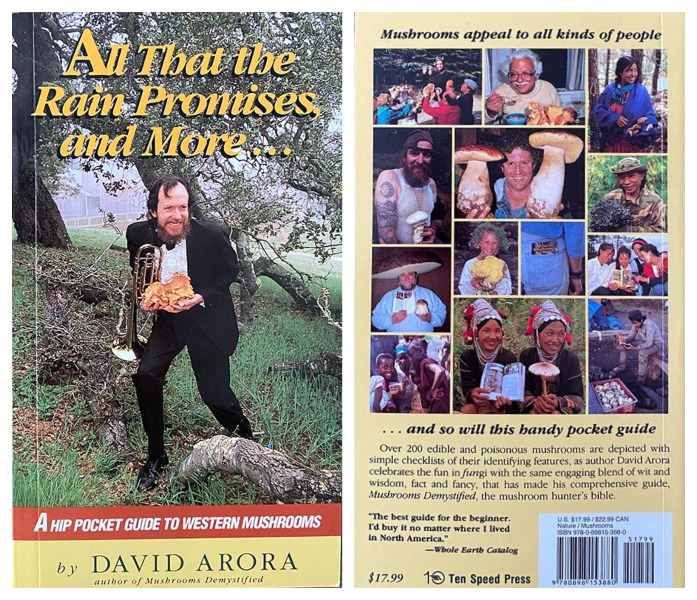
People describe “All That the Rain Promises and More” as the mushroom hunter’s bible, as this comprehensive pocket guide contains information on over 200 mushroom species.
Focusing on mushrooms found in the Western world, it provides illustrations and practical checklists of identifying features to help foragers correctly identify mushrooms and have fun.
The author aims to entertain and share the joy of foraging by including humor, wisdom, facts and stories, creating an informative and entertaining guide.
Mushroom foragers find this book easy to use and enjoy the fun facts and the author’s experiences and memories.
Pros
This book has several pros, including:
- Colorful illustrations
- Concise descriptions
- Checklists of identifying features
- Convenient small size
- Excellent humor
Cons
Cons of this book include:
- The text is only 8 points, so older people may need glasses to read it
- Focuses specifically on mushrooms found in the Pacific Northwest of the USA
7. “Mushrooms Demystified” by David Arora
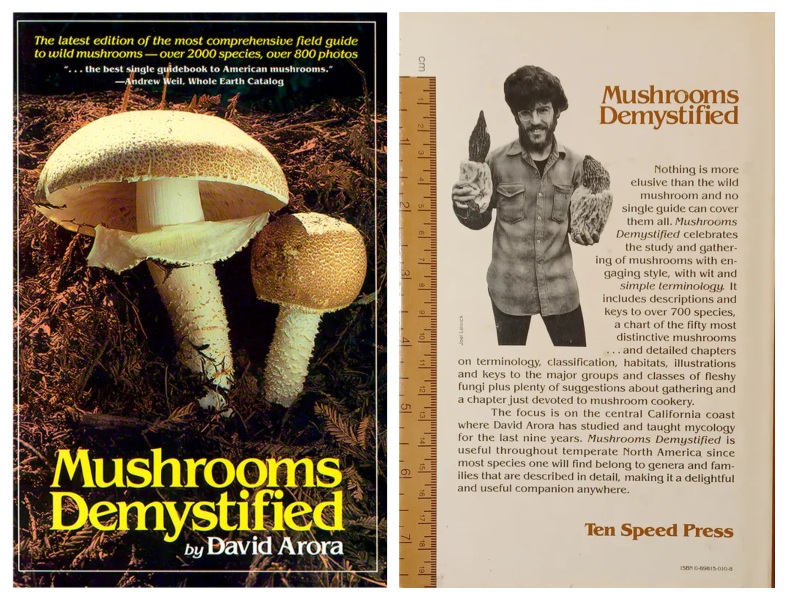
“Mushrooms Demystified” is a comprehensive mushroom field guide and reference book that contains descriptions and identification keys for more than 2000 species of mushrooms.
Although not all species have photos, there are over 950 photos, of which 217 are color photos found in the middle of the book.
However, most foragers find the detailed identification keys handier than the images for identifying mushrooms.
With so much information, it can be daunting, so the author has included a section for beginners containing a checklist for 70 of the most common mushrooms.
The book also has chapters explaining mushroom terminology, classification, habitats and the meaning of scientific mushroom names.
This mushroom reference book contains humorous observations and light-hearted comments, making it enjoyable, much like the author’s other field guide, “All that the Rain Promises and More.”
Pros
People describe this book as the mushroom forager’s bible, and it has many pros, including:
- Accurate, information-rich descriptions
- An enjoyable, humorous read
- Comprehensive identification keys that describe key characteristics
- Covers species that many other books do not
Cons
This book is so comprehensive it can be intimidating, and the cons include:
- It’s a thick, heavy book and not ideal to carry while foraging
- Most of the pictures are black and white, and not all species have photos
- The vast amount of information can be overwhelming for beginners
- Some of the information is a little outdated
8. “The Complete Mushroom Hunter” by Gary Lincoff
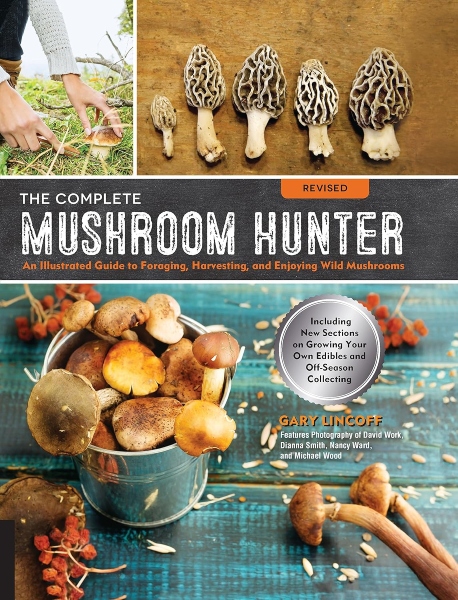
“The Complete Mushroom Hunter” is an Illustrated guide to foraging, harvesting, and enjoying wild mushrooms that draws on ancient knowledge lost to many.
Inside you’ll find:
- A brief history of mushroom foraging
- What equipment you’ll need
- An illustrated guide to common, wild edible and medicinal mushrooms
- Where to find wild mushrooms and how to identify them
- How to prepare and serve your mushrooms with recipes
Most importantly, the author provides information on toxic look-alikes and how to forage safely and includes an essential guide to poisonous mushrooms, the symptoms of poisoning and treatment.
Pros
This book contains a wealth of information, and its pros include the following:
- Well organized with lots of photos
- Easy to read with in-depth information
Cons
This large book may be a bit bulky to take into the field, and the cons include:
- Only covers a limited number of common mushrooms
- Key identifiers could be described in more detail
9. “The Mushroom Fan Club” by Elise Gravel

Many parts of the world have a common fear of mushrooms, leading to the idea that, to be safe, children should stay away from them in nature.
The “Mushroom Fan Club” aims to change this by presenting mushroom foraging to kids in an enjoyable way that ignites creativity and inspires a new generation of mushroom lovers.
The book provides simple, memorable information perfect for young mushroom fans.
While the book isn’t meant for the definitive identification of mushrooms, it offers a general look at various types found in the woods, complemented by engaging illustrations and stories.
By encouraging curiosity, The Mushroom Fan Club motivates children to explore their surroundings and discover the wonders of nature, including fungi.
Pros
Who can resist mushrooms with googly eyes? This popular book has many pros, including:
- Being well laid out and engaging
- Fun illustrations that appeal to children
- Conveying the author’s enthusiasm for mushroom foraging
Cons
This engaging children’s book doesn’t have many cons, and most enjoyed it except for a few people who feel it is not as informative as some of the author’s previous works.
10. “Mushrooming” by Diane Borsato
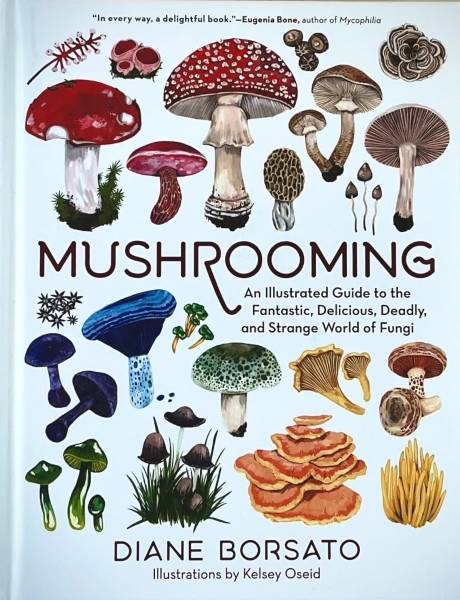
“Mushrooming” is a delightful illustrated book featuring over 100 types of mushrooms and providing insights and stories about these fascinating organisms.
It helps with mushroom identification and highlights how foraging can foster connections with nature that enhance our lives.
Ideal for novice foragers, this handbook is designed to ignite your curiosity and deepen your appreciation for the astonishing, tasty and sometimes dangerous world of fungi.
Mushrooming blends history, information, art and personal anecdotes and is not intended to be used as a mushroom identification field guide.
Inside, you’ll find 127 colorful illustrations and descriptions to help you learn the basic properties of various fungi, with recommendations on more in-depth field guides for those wanting to know more.
Pros
This informative, insightful and surprising book has many pros, including:
- Lots of funny personal experiences and anecdotes
- Beautiful illustrations
- Interesting, informative and perspective-shifting information
Cons
This book is not intended to be used as a field guide on its own, which disappoints some readers.
11. “Wild Mushrooms” by Kristen Blizzard
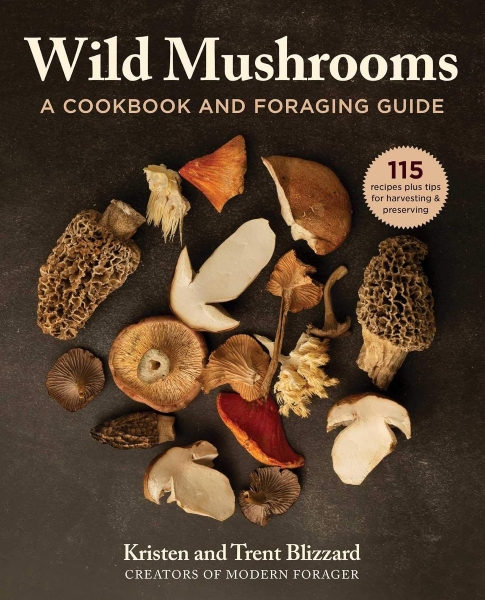
“Wild Mushrooms” is a cookbook and foraging guide filled with valuable insights from over 20 experienced foragers.
It aims to guide mushroom hunters on how to make the most of their haul with practical tips on how to transport, clean, and preserve mushrooms and 115 delicious, creative recipes organized by mushroom type.
In this book, you’ll learn methods for finding, cleaning, gathering, and storing mushrooms, with essential information about safety and edibility.
The book also covers preservation methods and has information on different mushroom varieties and their flavor profiles.
Pros
- Provides a range of unusual and delicious recipes
- Contains beautiful pictures and excellent descriptions
- Includes great information, helpful tips, and pointers for learning more
Cons
This is more of a cookbook than a foraging book, ideal for those interested in the culinary side of mushrooms, but not a solid foraging field guide.
12. “How to Forage for Mushrooms without Dying” by Frank Hyman

“How to Forage for Mushrooms Without Dying” is the perfect guide for anyone who enjoys walking in nature and wants to learn about 29 of the most common edible mushrooms they might find.
Unlike many mushroom field guides written by experts for other experts, this absolute beginner’s guide is aimed at complete newcomers who only want to know if they can eat a mushroom or not.
The author shares practical foraging tips and essential information that’s easy to apply in the field vibrantly and memorably.
For instance, to tell if a mushroom is a tasty morel or a dangerous false morel, cut it in half, “If it’s hollow, you can swallow,” he states.
Hyman’s straightforward advice and simple instructions give readers knowledge and a touch of caution, helping them recognize which mushrooms are safe to eat and which to avoid.
Pros
People consider this book one of the best guides for beginners, and it has many pros, including:
- Several excellent clear photos of each mushroom
- Written using approachable, easy-to-understand language
- Excellent, concise descriptions
- Small enough to take with you while foraging
Cons
It’s hard to beat this book if you’re looking for something for a complete beginner. The only con we found was a print fault, as the printing in some copies was a little blurry.
Best Mushroom Growing Books
If you’re most interested in growing mushrooms, we have another guide to the top 10 best mushroom growing books for you, but we have added some of our favorites to this list, including:
13. “Growing Gourmet & Medicinal Mushrooms” by Paul Stamets
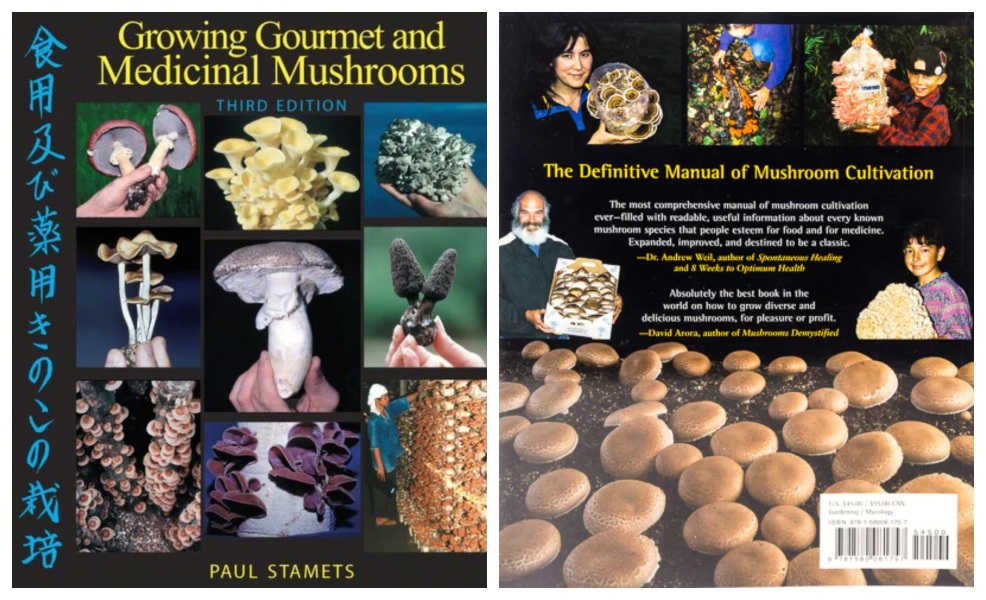
“Growing Gourmet & Medicinal Mushrooms” is a comprehensive guide to growing mushrooms by a well-known mycologist and mushroom cultivation techniques pioneer.
This best-selling book covers every aspect of mushroom cultivation in-depth and will benefit all growers from beginner to advanced.
“Growing Gourmet & Medicinal Mushrooms” contains 592 pages split into 25 information-packed chapters, making it a must-have for anyone serious about learning more about mushroom growing.
Pros
One of the most definitive guides to growing mushrooms, this book has many pros, including:
- In-depth information on all aspects of mushroom growing
- Invaluable troubleshooting guide
- Lots of tips and tricks
- More than 500 photographs and illustrations
- Growth parameters for 31 species of mushrooms
Cons
Because Paul Stamets goes into such detail, there’s a lot of technical information, and the cons include the following:
- Not an easy read
- Overwhelming amount of information for beginners
- Most of the photos are black and white, and some, although still relevant, are a little dated.
14. “Mycelium Running” by Paul Stamets
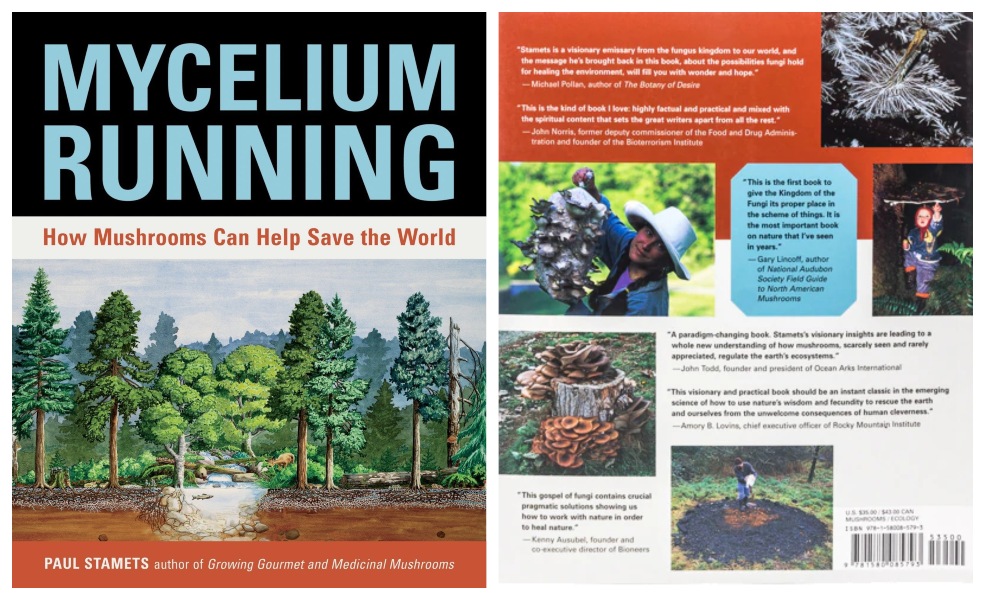
“Mycelium Running” by mycologist Paul Stamets is a great read. While it still has some textbook elements, it’s more approachable than “Growing Gourmet and Medicinal Mushrooms.”
It’s not just about growing mushrooms but also covers how mushrooms impact the environment and their various uses.
“Mycelium running” offers practical tips for both beginners and those with some experience on how and why to cultivate mushrooms outdoors.
The techniques discussed don’t require expensive tools or specialized lab settings, making it ideal for gardeners and permaculture enthusiasts who want simpler methods.
If you want to grow mushrooms for better yields, pest control, or to minimize water runoff in your garden or farm, this book is just what you need.
Pros
This guide on healing the earth through mushroom farming offers many benefits, such as:
- Engaging and practical tips about growing mushrooms
- A stunning layout featuring over 300 vivid, full-color images
- An enjoyable read that’s informative even for those not interested in growing mushrooms.
Cons
This book offers a wealth of information, but it has some drawbacks, including:
- Complex technical terms that might be tough for newcomers to understand
- A lot of content that could feel like too much at once
15. “Radical Mycology” by Peter McCoy
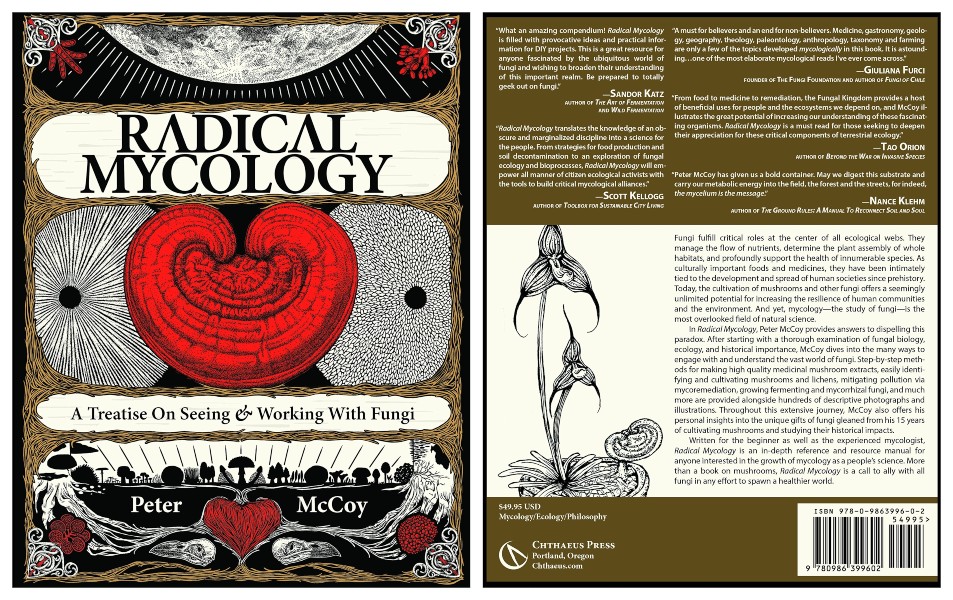
“Radical Mycology” is an engaging and comprehensive guide to fungi, packed with innovative ideas and practical tips for mushroom growers and fungi fans alike.
This extensive 650-page book by Peter McCoy, a self-taught mycologist with over two decades of experience, covers many subjects.
The book presents mycology in a fun, approachable manner, emphasizing the connections between humans and fungi.
It examines various ways to utilize fungi for food, medicine, and environmental benefits.
The book lays a solid foundation. Beginning with detailed chapters on mushroom structure, life cycles, identification, and their environmental roles.
From there, it dedicates a significant portion to mushroom cultivation, starting with basic concepts for beginners and progressing to more specific techniques, tips and advanced details.
The emphasis is on practical, cost-effective methods for growing mushrooms, and the author shares valuable insights on creating, recycling or finding affordable supplies and equipment.
Additionally, the book includes in-depth information on what McCoy terms “regenerative natural mushroom farming,” along with insights into mycoremediation and psychoactive mushrooms.
Pros
This detailed book offers valuable insights, and its pros include the following:
- Coverage of various aspects of fungi
- Intriguing quotes and facts in sidebars
- Comprehensive resource lists, appendices, and references
- A lively and unique writing style that relates complex ideas to everyday experiences
- Practical advice and cost-effective methods and suggestions
Cons
No one can fault the breadth of content and information in this book, but there are some cons, including:
- The quality of the photography and image reproduction
- The durability of the binding
16. “Organic Mushroom Farming and Mycoremediation” by Tradd Cotter

“Organic Mushroom Farming and Mycoremediation” is a well-regarded book that promotes a comprehensive approach to growing mushrooms using organic methods.
Tradd Cotter, the author, is a microbiologist, professional mycologist, and organic gardener with over 22 years of experience.
He focuses on simple cultivation methods, enabling people to grow mushrooms anywhere using a range of materials.
The book spans 400 pages and is divided into four sections.
The first section introduces the fundamentals of mushroom cultivation, guiding readers in selecting the correct mushrooms and effective growing techniques.
The second section thoroughly examines mushrooms’ roles and their possible applications in our society.
The third section addresses advanced methods and is aimed at experienced growers seeking to start a commercial mushroom operation.
The final section provides a detailed reference for the most commonly grown mushroom species.
Pros
This mushroom growing book takes a different approach from many others, and its pros include:
- Unique insights into organic growing methods and ideas for off-grid cultivation.
- A wealth of fascinating information and details about innovative research.
- Excellent photographs and illustrations that enhance the content.
Cons
This book serves as an informative and motivational reference rather than a comprehensive how-to guide, and its cons include the following:
- It does not thoroughly cover all cultivation techniques.
- The author’s enthusiasm sometimes leads him to explore intriguing but non-essential subjects.
17. “The Psilocybin Mushroom Bible” by K Mandrake
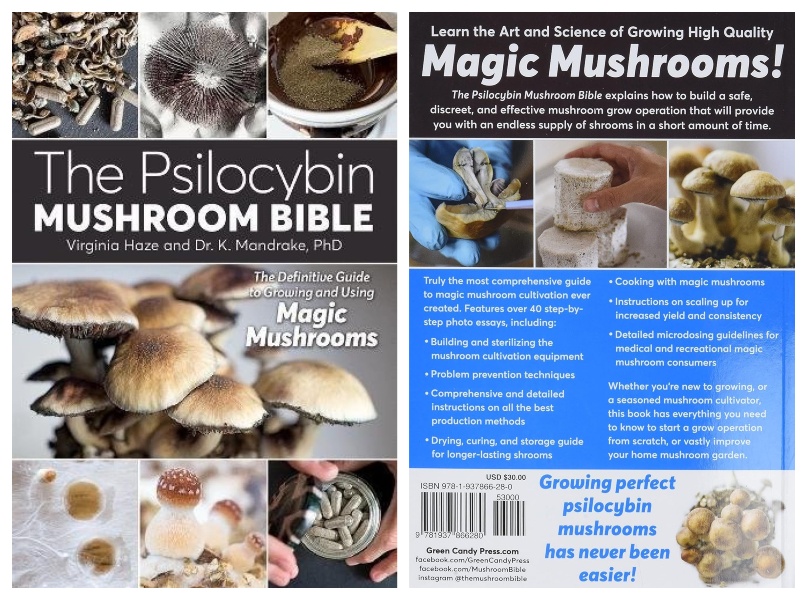
“The Psilocybin Mushroom Bible” delves into every aspect of magic mushroom cultivation, making it the most detailed and comprehensive resource on this topic available.
Readers will discover how to grow magic mushrooms quickly, safely, and effectively.
The 380-page book includes over 40 detailed photographic guides covering each phase step-by-step.
Pros
This informative book has several pros, including:
- It’s easy to read and practical for beginners
- Written in a friendly, relatable tone
- Contains in-depth content and lots of excellent photos
- Full of practical information and tips
Cons
More advanced mushroom growers feel this book has a few cons, including:
- Not being detailed enough on specific procedures
- Containing some outdated information
Best Medicinal Mushroom Books
Medicinal mushrooms are a hot topic at the moment, and they’re increasing in popularity as research confirms their potential health benefits.
If you want to learn more about how to use these remarkable organisms, medicinal mushrooms books will guide you, and some of the most popular include:
18. “Healing Mushrooms” By Tero Isokauppila
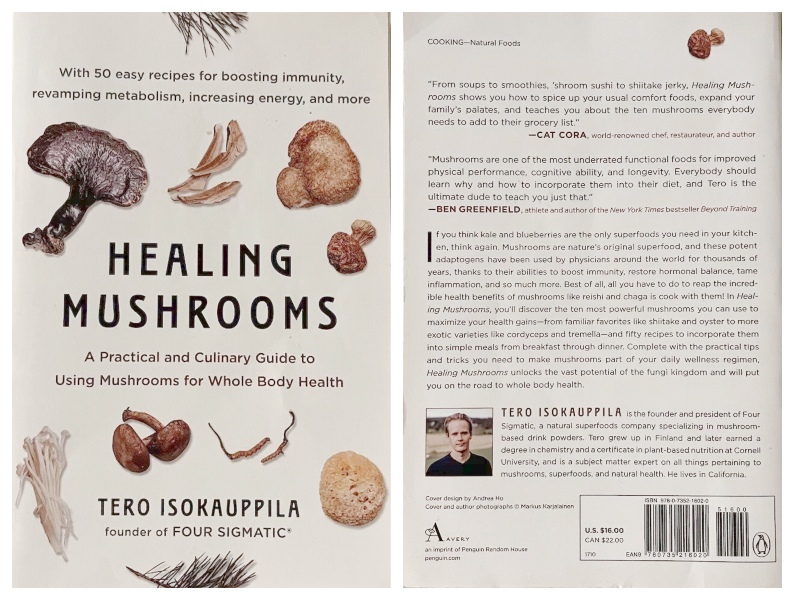
In “Healing Mushrooms,” you’ll discover ten popular medicinal mushrooms that you can easily incorporate into your daily meals to boost your health.
This book provides a broad overview of the potential benefits of including mushrooms in your diet but does not delve into the subject or include research-backed data.
Some mushrooms in the book, like tremella and cordyceps, might seem unusual and exotic to Westerners, but they’re readily available online as extracts and easy to use.
Other common mushrooms, often found in grocery stores, like shiitake, oyster and enoki mushrooms, also offer impressive health benefits. You just need to know how to use them.
This well-written guide is loaded with practical information, engaging illustrations, stunning full-color photos and 50 delicious recipes that cover breakfast, lunch, dinner, and even dessert!
Healing Mushrooms reveals the incredible benefits of functional mushrooms and serves as a practical resource for enhancing your health and wellness with mushrooms.
Pros
Pros of this book include:
- An informative, easy read
- Unique recipes ordered by the body systems they support
Cons
This medicinal mushroom book focuses on specific mushrooms and its cons include:
- Recipes focused on using mushroom extracts, not fresh mushrooms
- Not in-depth enough and lacking scientific references
19. “Medicinal Mushrooms: A Clinical Guide” by Martin Powell
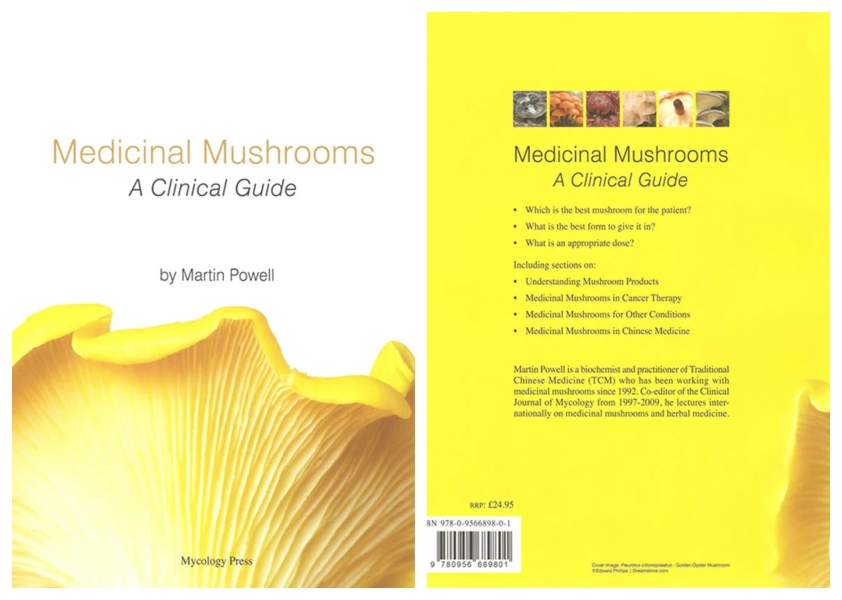
For anyone curious about the medicinal properties of mushrooms, “Medicinal Mushrooms: A Clinical Guide” is an excellent choice.
Powell combines his knowledge of biochemistry and Traditional Chinese Medicine to demonstrate practical applications of these mushrooms for treating specific health issues.
Although the book is aimed at healthcare professionals, it is straightforward enough for general readers to appreciate.
It’s a well-organized and thorough resource, making it essential for anyone wanting to explore this subject further.
Pros
This well-written informative book has many pros, including:
- Well-organized, accessible information
- Contains lots of resources and references
- Information on 20 medicinal mushrooms and their applications
- Appendices to help you search by mushroom or health condition
Cons
This book is aimed at natural health practitioners and thus has a few cons for other readers, including:
- Uses Latin names and technical terminology
- Lacks details on preparation
20. “The Fungal Pharmacy” by Robert Rogers
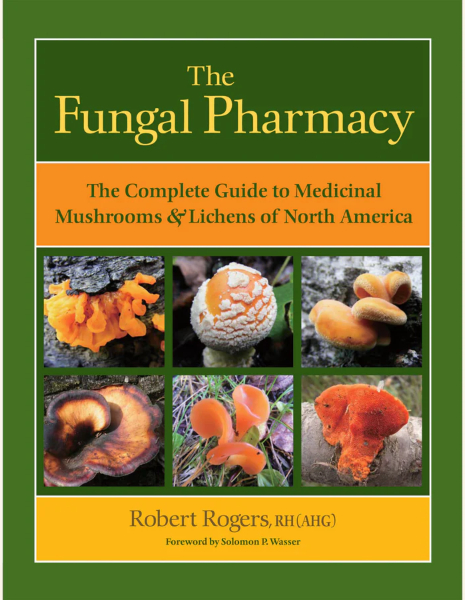
“The Fungal Pharmacy” is a comprehensive guide to identifying and utilizing medicinal fungi in North America.
In this book, herbalist Robert Rogers introduces readers to over 300 medicinal mushrooms and lichens native to North America.
The Fungal Pharmacy details the medicinal qualities and distinct characteristics of each mushroom and lichen, featuring:
- Active chemical compounds
- Methods for preparing extracts, essences, essential oils, and more
- Historical and contemporary uses
- Cultural, religious, and literary importance, along with interesting facts about their names and history
With 200 vibrant color photos and comprehensive descriptions to help with identification, it’s an invaluable resource for mycologists, mushroom enthusiasts, wildcrafters and anyone seeking natural health solutions.
Pros
This information-packed book has several pros, including:
- Detailed, well-written information
- Lots of scientific references
- Full-color photos
Cons
This is a science-backed medicinal mushroom book has a few cons, including:
- Lots of scientific names and terminology, making it too technical for many people
- Lacking a medical conditions index
- Problems with the binding
Final Thoughts
We hope you found this article helpful and that these exceptional books will assist you in learning more about fungi and how they can improve your life.
Many mycologists start out foraging for fungi and, as they learn more, move on to growing their own mushrooms to be enjoyed fresh or used to make medicinal mushroom tinctures.
No matter what stage you’re at, mushroom books are fascinating and inspirational, but if you’re more of a hands-on type learner, then a mushroom growing course may be what you need.
To learn more, visit our Mushroom Growing Hub or try one of our online mushroom cultivation courses.
